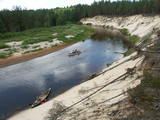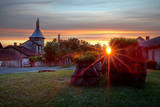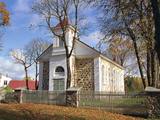| Нo | Название | Описание |
|---|---|---|
|
Впервые в Латвии (в 1996 г.) на склоне берега реки Абула хозяин занялся выращиванием кустовой черники. Теперь здесь зеленеют просторные поля кустовой черники. Торговля ягодами и саженцами, экскурсия с дегустацией и консультации, проектирование садов и планирование работ по озеленению. |
||
|
This is a farm where there are some 10 different kinds of strawberries on many hectares of land. Anita Rescenko offers a six-day strawberry cure to improve your health. Pick and taste strawberries, purchase them fresh and clean. There are strawberry masks, dishes prepared with strawberries, clay masks and compresses against joint pains. Visitors can learn flower arranging, boat around the local lake, etc.
|
||
|
Tāpat kā Ventspils Rātslaukums, arī Tirgus laukums ir uzskatāms par pilsētas vēsturiskā centra nozīmīgu daļu, kura apkaimē ir saglabājies senais ielu plānojums. Kādreizējā Rātsnama vietā tagad slejas kariljonu zvana pulksteņu tornis. Tas zvana katru stundu, bet 12:33:44 un 00:33:44 ar īpašu melodiju ieskandina astronomisko Ventspils laiku. Tirgus laukumā ir aka, kas saulainā laikā darbojas arī kā Saules pulkstenis. Monētu automātā var izkalt īpašu piemiņas monētu. |
||
|
Находится на Пулеметной горке, которая является одной из самых высоких точек Длинной дюны. Рядом находится памятник доблестным латышским стрелкам, которые потерпели большие потери в ходе Рождественских боев в конце 1916 г. Просматриваются большие лесные массивы до самой Юрмалы и болото Мазтиреля, на котором хорошо выделяется место бывшей узкоколейной железнодорожной насыпи. Входит в Мемориальный парк Рождественских боев, где можно осмотреть музей Мангали, восстановленный “Немецкий вал”, памятники и другие объекты. |
||
|
Ансамбль поместья в Милзкалне на берегу речки Слоцене начал создаваться в 15-м веке как закрытый комплекс франкского типа для хозяйских нужд ордена и являющийся в наши дни единственным сохранившимся образцом укрепленного поместья такого типа (как место укрытия для помещиков в случае нападения) в Латвии. В конце 17-го века были построены превратные башни с роскошными флюгерами, а в 18-19 веках – также хозяйственные здания. От первоначальной застройки сохранилась стена с бойницами. В одном из крыльев комплекса расположен Латвийский музей дорог. В главном здании поместья расположена гостиница, здесь предлагают экскурсии и дегустацию даров села. |
||
|
The “Dabas zirgi” centre for horse and human welfare is in the historical Mežinieku neighbourhood in suburban Rīga, and it will be a revelation to those who wish to have a sense of belonging related to Latvia and its environment. Touch the forest, enjoy the cool water of the Misa River, encounter a swamp or see the breath of a horse on a foggy morning. You’re welcome to spend a longer amount of time at this venue with new glamping opportunities in a lovely forested area next to the steep shores of the Misa River. This offers complete silence with only the woods and the river nearby. Along with the horses, of course. “Dabas zirgi” offers strolls with a horse, tours involving feeding the animals, as well as horseback rides. Family celebrations are perfect here with a lean-to, a grill, and a pot on a campfire. Contact the venue in advance to arrange for prepared breakfast, lunch and dinner. There is also a sauna with a jacuzzi. |
||
|
The Narūta River which flows out of Lake Ežezers is approximately 1 km long and ends at the small Obiteļi windmill lake. On the right bank of the river is a windmill that was built around 1900. Today the site has the Obiteļa leisure centre with a sauna and banquet facilities. |
||
|
Seno un mūsdienīgo amatu prasmju popularizēšana, izkopšana un tālāknodošana. |
||
|
Esko Farm is a family business which focuses on making dairy products from their own lifestock. Farm's products include yogurt ice creams, cheeses, yogurts and so on. It's possible to take a tour around the farm, get to know the animals as well as have degustation of the farm's products. |
||
|
Приобретение выращиваемых в питомнике саженцев (яблони, груши, вишни, сливы, черная смородина, смородина, крыжовник, малина, айва, арония черноплодная и сладкая рябина). Хозяева дают советы по садоводству и выращиванию фруктовых деревьев. Предлагают приготовленные в хозяйстве цукаты. |
||
|
В винном погребе Murimäe предлагается вино из лучшего эстонского винограда. Хозяйство занимается производством виноградного, ягодного и фруктового вина, здесь также проводятся дегустации и курсы. |
||
|
Some 250 deer graze on 100 ha of land in the Umurga Parish. The farm also offers a look at peacocks, rabbits, sheep, goats and a pony. Biological products are on sale, and visitors are welcome all year round.
|
||
|
Создан для защиты и сохранения нетронутых лесов, болот и естественной среды живописных лесных озер. Экскурсии в сопровождение гида по природе, фотоохота. |
||
|
Neparastais objekts meklējams Teteles pamatskolas parkā, Lielupes labajā krastā. Torni cēlis (dažādas versijas par celšanas gadu: 1840. g. vai 1885. g.) Tetelmindes muižas barons Frīdrihs Bērs, jaunākais, par godu saviem viesiem, kas ieradušies pie barona uz medībām. Tornis kalpojis kā medību skatu tornis un vieta apkārtnes novērošanai. Godinot viesus, tajā uzvilka karogu. Apskatāms no ārpuses. |
||
|
По индивидуальным заказам делает элегантные предметы интерьера - деревянную мебель (шкафы, кровати), лестницы и др. полезные в хозяйстве дела. Поделится знаниями и опытом. Автор нескольких деревянных алтарей. |
||
|
Atrodas ~ 1,5 km ziemeļos no Krāslavas centra, Jāņupītes krastā (ir norāde). Pēc atsevišķiem savrupatradumiem var spriest, ka pilskalns apdzīvots laikā no I g. t. pr. Kristus līdz vēlajam dzelzs laikmetam. Domājams, ka savu nosaukumu tas ieguvis šeit sastopamo mālu dēļ. Nelielas mālu ieguves vietas pilskalna nogāzēs ir redzamas arī šodien. Saglabājies nostāsts, ka grāfs Plāters šeit apraudājis savu sievu, kuru pats neuzticības dēļ licis iemūrēt pazemē. |
||
|
Tiek uzskatīta par vecāko alus darītavu Ziemeļeiropā. Tā tika uzcelta 1878. gadā, un tās pirmais īpašnieks bija grāfs Emanuels fon Zīverss (Sievers), Cēsu pils muižas saimnieks. Savukārt 1922. gadā alus darītavu pārpirka Cēsu uzņēmēji un sāka tur ražot arī vīnu, sulas un minerālūdeni. Uzņēmums "Cēsu alus" šeit alu un atspirdzinošus dzērienus ražoja no 1976. līdz 2001. gadam, bet šobrīd tas ir pārcēlies uz jaunām telpām. Šobrīd ēkā tiek organizētas dažādas izstādes, kā arī ēku var apskatīt no ārpuses. |
||
|
Biedrība "Latvijas Slieku audzētāju asociācija" tika nodibināta 2010. gada 1.septembrī ar mērķi attīstīt sliekkopību un vermikomposta ražošanu Latvijā. Pamatnodarbošanās - vermikomposta ražošana. |
||
|
Нагльский Римско-католический костёл Св. Иоанна Крестителя в 1862 году начал строить помещик Набелс. Нагльский
костёл изначально был филиалом Вилянского костёла, где слу-
жили бернардийские монахи этого костёла.
|
||
|
Maršruts "Murjāņi - Līgatne" ved caur Gaujas senieleju ar devona smilšakmens atsegumiem, raksturīgo augu valsti un dzīvniekiem. Krastos sastopami Latvijā lielākie nogāžu un gravu meži ar liepām, ozoliem, gobām un ošiem. Upes līkumos palienē aug baltalkšņu un vīksnu audzes. Uz koku stumbriem atrodams plaušķērpis. Senieleja bagāta ar sausokņiem un kritalām, tāpēc Gaujas krastu mežos dzīvo visu Latvijā sastopamo dzeņu dzimtas sugu putni. Smilšainajās Gaujmalas pļavās un Gaujas vecupēs ir bagātīga bezmugurkaulnieku fauna. Upes krastos ir smilšakmens klintis ar čurkstu alām un zivju dzenīša ligzdām. Klinšu pakājē iztek avoti, kas uztur mikroklimatu ielejā. Gauja ir nozīmīga arī kā Latvijas lielākā lašupe. Maršruts ir daļēji marķēts un papildināts ar norādēm un informācijas stendiem. |
||





















